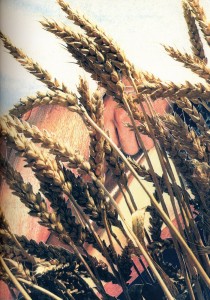
Inspired by Sina’s recent post, I was thinking again about ekphrastic poetry, poetry that traditionally has been written about or for art objects/works. Many of my own poems are informed by visual art, film, music, and live performance. Art, for lack of a better term, often serves as a guide. It shows me things I might not have seen otherwise, so acts as a tool for vision/visionary experience.
Writing poetry 'after' or 'in relation to' art is a qualitatively different activity, I’ve found, from, say, having a conversation about art with a friend, or trying to write a review of an art show or critical essay about a particular artist's practice. The poem—many of the poems I write at least—would like to grasp some essence about the work, or to speak from the position of the process by which the art object came into being/to have meaning.
It is as if there is a circuit or feedback loop between the poem—the poem as act of composition, revision, and/or construction—and the art object. Likewise the contexts which may surround that object whether historical fact/narrative/event, or artists’ biography, or art historical scholarship. So that when one composes they may be aware of many layers of meditation between themselves and some communion with the work of art.
The poem may become a site for varying degrees of 'naive' experience, seeing the art object or engaging with it through any number of different filters, veils—at such a distance from anything one might call the ‘thing in itself.' The poem also can act pre-critically or post-critically—as a kind of processor for 'understanding.' What we ‘see’ in the work of art; the way the art sees us through the lens of social processes, cultural antagonism, the institutional situations wherein it appears (whether magazine, museum, gallery, site, classroom, film, internet, etc.).
The poem, for me, composes ideas, percepts, and thoughts while they are still in process. It is a learning machine or a vision machine engaged with what the art object might reveal as culturally meaningful or, on the other hand, as a withdrawal from cultural meaning—legibility, visibility, exchangeability. It is a bachelor machine inasmuch as it is bounded, prosthetic, and artificial.
Writing can engage the art object through Bardo (like in the work of Jalal Toufic and Leslie Scalapino, or the work I wrote after Maya Deren’s oeuvre, "Into Bride: Army of Roses," in which I meditated on Deren’s protagonist’s suicide in her 1942 film, Meshes of the Afternoon). Here, the art object guides one through a set of images that construct a universe of concepts telling of a metaphysics, of socio-political allegory, or both. Aesthetic facts find their use or application. They are ripe for other narratives, fictions, conceptualizations. The more we turn them over, the more we feel they yield. (One feels this inexhaustibility especially with Toufic's work, which is highly iterative, creating differences within perceived repetition).
Writing can also attempt to embody the formal conditions of a work of art, such as in many of Creeley’s collaborations with artists (thinking here of his “Numbers” series w/ Robert Indiana) or many of the writers/artists collaborations published by Steve Clay’s Granary Books. When I made the book Tears Are These Veils with the visual artist Abby Walton, I also had such an approach to writing in mind, the line acting in a similar way to Walton’s physical cutting away at/of images (in the book, Walton’s images are constituted by the brilliant overlaying of two photographic images upon one another whereupon Walton removes visual content with an Exacto pen to create a third image). The effect (eschewing digital manipulation via Photoshop/Illustrator) is quite disorienting and stunning.
For the past few years I have been writing more and more art reviews/essays, and this past fall had the chance to review Paul Chan’s show at Greene-Naftali gallery in Chelsea, NYC, “Sade for Sade’s Sake.” In preparation to write the review, I took notes for two hours in the gallery. The result (biproduct?) was the poem "After Paul Chan's Sade," which acted as a kind of processor for whatever I would eventually ‘see’ through the review/essay format.
What often strikes me in writing poems 'after' art while also writing a review/essay 'about' the same art object(s) is how inadequate actually the review/essay is in comparison to how I come to 'know' or 'understand' art object(s) through poetic composition. In a very concrete way, this sense of disjunct between 'poem' and 'review/essay' gives me hope that poetry can do things that discursive critical prose simply can’t. Intuit? Embody? Propriocept? Undergo? Transcend? (I’m still not sure the proper term for it.)
Regardless, the poem very often can appear to do something much more immediately than prose in my experience, though critical prose can travel more quickly, communicate more easily to a wider discourse. Whatever one gains in speed (the speed of intuitions, understandings, lightning flashes) one perhaps loses exponentially in communicability.
Thom Donovan lives in New York City where he edits Wild Horses of Fire weblog (whof.blogspot.com) and...
Read Full Biography

